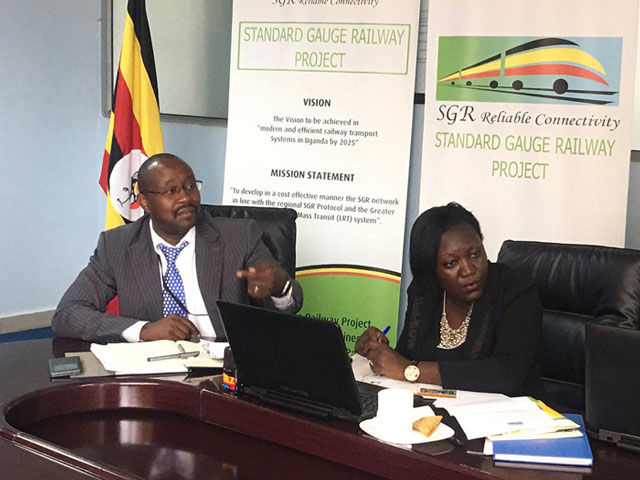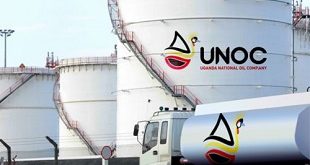
Construction of the Ugandan leg of the Standard Gauge Railway (SGR) system will commence fully soon after Kenya starts construction of the Naivasha-Kisumu- Malaba stretch.
Officials in charge of the project in Uganda said that other than the fact that they are still seeking funding, it would not make economic sense to start construction of the Malaba-Kampala leg before the Naivasha-Kisumu-Malaba route starts or is completed.
Meantime, officials in charge of the project in Uganda are going on with land compensation and securing adequate funding for the Malaba-Kampala project.
Project coordinator Eng. Kasingye Kyamugambi, the Senior Civil Engineer in charge of Design Eng. Kabogoza and Diana Apio the Head Public Relations & Corporate Affairs Standard Gauge Railway Uganda on Tuesday also explained why the costs of the Ugandan project cannot be the same as that in Kenya or Ethiopia.
The SGR officials were responding Tuesday to a Ugandan parliamentary committee that demanded a complete review of the Uganda-Kenya Standard Gauge Railway Project.
Committee members recently visited railway lines in Ethiopia and Djibouti, and said they found that costs associated with Uganda’s new line were much higher.
The Uganda SGR officials said the variances are due to factors like distance from the port, terrain in addition to labour and land compensation costs.
Also considered is the class of the project, with Uganda’s Class one, with electrical trains, Kenya’s currently with diesel engines, and Ethiopia’s Class 2, with a mixture of diesel and electrical engines.
The Ugandan trains will carry significantly heavier loads than those in Ethiopia as well.
The 1,740km (1,081 miles) of the entire SGR project is expected to cost $12.8bn. The railway will be funded by a China’s Exim bank and built by a Chinese construction company. It is set to open in Kampala in late 2020.
The Ethiopian-Djibouti line, which opened in October, cost $3.4 Billion for 656km while the Ugandan leg of 273km will cost $2.3bn. Kenya’s 472km stretch will cost $3.4billion.
“Cost variances are due to unique project needs and ground conditions for infrastructure set up,” said Eng.Daniel Kabogoza, the Senior Civil Engineer in charge of Design.
“You cannot directly compare costs between the Uganda SGR, the Kenyan or Ethiopian one. It is like comparing apples and oranges because of the so many different factors at play on the ground.”
Project coordindator Eng. Kasingye Kyamugambi , Eng. Kabogoza and Diana Apio, the Head Public Relations & Corporate Affairs Standard Gauge Railway Uganda explained to the media the various factors affecting design.
They revealed that Uganda chose electricity trains because they have been assured of adequate power from the ongoing energy projects at Karuma and Isimba.
The decision to go electric was also based on the factor that after completion, the long term costs of operation and maintenance are cheaper than diesel.
Ethiopia and Kenya also have the added advantage of having their own ports to deliver material at a lesser cost, and bigger populations which makes labour and related costs cheaper.
In a presentation, they showed that the Malaba-Kampala project goes through many major urban centres, calling for major sub-construction of viaducts to avoid disrupting traffic, in addition to a 1km bridge of River Nile that on its own will cost $300million to construct.
Because of the high speeds of the trains, travelling up to 120km per hour, most of the old rail route is not conducive, and redesigns have had to be made to many sections.
Eng. Kasingye Kyamugambi stressed that they are guided by the Northern Corridor Integration Projects (NCIP) protocol signed in May 2014. “The SGR Protocal gives us the collaborative framework among the four states especially on standards, specifications and for seamless connectivity,” he said.
The NCIP involves Uganda, Kenya, Rwanda and South Sudan. Tanzania is not a member of the project, and is developing its rail on its own as part of improving connectivity in the East African region.
When completed, goods will be able to move from Mombasa to Kampala in 24 hours, up from 12 days, while the trains will haul up to 4,000 tons, compared to about 800 tons today.
SGR: Ministerial Response to Parliamentary Report by The Independent Magazine on Scribd
 The Independent Uganda: You get the Truth we Pay the Price
The Independent Uganda: You get the Truth we Pay the Price


